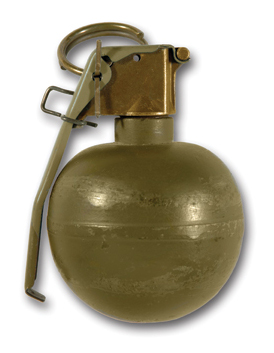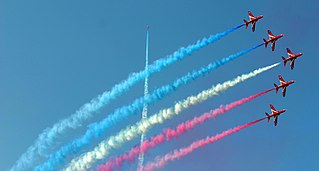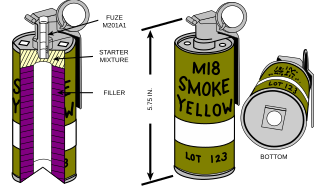
The AN-M8 HC Smoke Grenade designated as the Army/Navy Model 8 HC Smoke Grenade (AN-M8 Smoke HC) is a US military grenade used as a ground-to-ground obscuring or screening device or a ground-to-air signaling or target-marking device. [1] [2]

The AN-M8 HC Smoke Grenade designated as the Army/Navy Model 8 HC Smoke Grenade (AN-M8 Smoke HC) is a US military grenade used as a ground-to-ground obscuring or screening device or a ground-to-air signaling or target-marking device. [1] [2]
Developed in the 1940s, using a sheet-steel cylinder body that can emit a dense cloud of white smoke that would last from 105 to 150 seconds.
The AN-M8 was used extensively by American or other allied forces throughout World War II to the 1990s. As of the September 2000 version of FM 3-23.30 Grenades and Pyrotechnic Signals, the AN/M8 was listed as obsolete.
It is used for smoke screening, target marking, and signalling, although the M18 colored smoke grenades are mainly used for the latter.
| Army/Navy Model 8 HC Smoke Grenade (AN-M8) | |
|---|---|
| Color/Markings | light green body with black markings and a white top |
| Body | Sheet steel cylinder |
| Fuze assembly | M201A1 Pull-ring Igniter. A "mouse trap" type igniting fuze with a 1.2 to 2.0 second delay. Ignition ignites the filler and expels it from the grenade body |
| Filler | 19 ounces of Type C, hexachloroethane (HC smoke) mixture |
| Weight | 24 ounces (680 g) |
| Safety clip? | No |
| Range | Can be thrown 30 feet by an average soldier before it ignites. It can be thrown further while igniting in flight |
| Duration | The grenade emits a dense cloud of white or gray smoke that lasts for 105 to 150 seconds (1.75 to 2.5 minutes) |
When employing the M18 or AN-M8 HC hand grenade, it may be desirable to use one of these grenades without the fuze. To do this, the following procedure should be used in combat only:
The HC smoke of the M8 is more toxic than that of the M18 grenade. The fumes comprise an acidic smoke of zinc chloride (ZnCl2), which produces hydrochloric acid on contact with water. [3]

A shell, in a military context, is a projectile whose payload contains an explosive, incendiary, or other chemical filling. Originally it was called a bombshell, but "shell" has come to be unambiguous in a military context. A shell can hold a tracer.

A smoke grenade is a canister-type grenade used as a signaling device, target or landing zone marking device, or as a screening device for unit movements.

In an explosive, pyrotechnic device, or military munition, a fuse is the part of the device that initiates function. In common usage, the word fuse is used indiscriminately. However, when being specific, the term fuse describes a simple pyrotechnic initiating device, like the cord on a firecracker whereas the term fuze is used when referring to a more sophisticated ignition device incorporating mechanical and/or electronic components, such as a proximity fuze for an M107 artillery shell, magnetic or acoustic fuze on a sea mine, spring-loaded grenade fuze, pencil detonator, or anti-handling device.

A smoke screen is smoke released to mask the movement or location of military units such as infantry, tanks, aircraft, or ships.
The British No. 69 was a hand grenade developed and used during the Second World War. It was adopted into service due to the need for a grenade with smaller destructive radius than the No. 36M "Mills bomb". This allowed the thrower to use a grenade even when there was little in the way of defensive cover. In contrast, the much greater destructive radius of the Mills bomb than its throwing range forced users to choose their throwing point carefully, in order to ensure that they would not be wounded by the shrapnel explosion of their own grenade.

White phosphorus munitions are weapons that use one of the common allotropes of the chemical element phosphorus. White phosphorus is used in smoke, illumination, and incendiary munitions, and is commonly the burning element of tracer ammunition. Other common names for white phosphorus munitions include WP and the slang terms Willie Pete and Willie Peter, which are derived from William Peter, the World War II phonetic alphabet rendering of the letters WP. White phosphorus is pyrophoric ; burns fiercely; and can ignite cloth, fuel, ammunition, and other combustibles.

The M67 grenade is a fragmentation hand grenade used by the United States military. The M67 is a further development of the M33 grenade, itself a replacement for the M26-series grenades used during the Korean and Vietnam Wars, and the older Mk 2 "pineapple" grenade used since World War I.
The military of the United States has used many different types of hand grenades since its foundation.

Colored smoke is a kind of smoke created by an aerosol of small particles of a suitable pigment or dye.

The United States Armed Forces has created a plethora of different types of 40 mm grenades in both the low-velocity 40×46 mm and high-velocity 40×53 mm calibers which uses what it calls a high-low propulsion system which keeps recoil forces within the boundaries of an infantry weapon. Presented on this page is a basic overview.
The No. 77 grenade was a British white phosphorus grenade introduced in September 1943 and used during the Second World War. The No. 77 consisted of around 225 grams of white phosphorus, an impact fuze and a tin casing. It was intended for laying down smoke screens and as a signalling device. The grenade was also very effective as an anti-personnel, incendiary weapon. As well as being issued to the Home Guard, the No. 77 grenade was issued to the British army. This grenade was fitted with an "all-ways" action impact fuze designed to set the grenade off when it hit a surface - the fuze was called "all-ways" as it was designed to work no matter which way the grenade landed.

The M18 Colored Smoke Grenade is a US Army grenade used as a ground-to-ground or ground-to-air signaling device, a target or landing zone marking device, or a screening device for unit maneuvering.
A smoke composition is a pyrotechnic composition designed primarily to generate smoke. Smoke compositions are used as obscurants or for generation of signaling smokes. Some are used as a payload of smoke bombs and smoke grenades.
In military munitions, a fuze is the part of the device that initiates function. In some applications, such as torpedoes, a fuze may be identified by function as the exploder. The relative complexity of even the earliest fuze designs can be seen in cutaway diagrams.

A grenade is an explosive weapon typically thrown by hand, but can also refer to a shell shot from the muzzle of a rifle or a grenade launcher. A modern hand grenade generally consists of an explosive charge ("filler"), a detonator mechanism, an internal striker to trigger the detonator, an arming safety secured by a transport safety. The user removes the transport safety before throwing, and once the grenade leaves the hand the arming safety gets released, allowing the striker to trigger a primer that ignites a fuze, which burns down to the detonator and explodes the main charge.

An artillery fuze or fuse is the type of munition fuze used with artillery munitions, typically projectiles fired by guns, howitzers and mortars. A fuze is a device that initiates an explosive function in a munition, most commonly causing it to detonate or release its contents, when its activation conditions are met. This action typically occurs a preset time after firing, or on physical contact with or detected proximity to the ground, a structure or other target. Fuze, a variant of fuse, is the official NATO spelling.
The Frangible Grenade M1 was a specially designed factory produced molotov cocktail created by the United States in 1942 as it entered World War II (1939–1945). It was designed to provide lightly armed personnel with simple, uncomplicated weapons that were easy to mass-produce. It provided a cheap stopgap means of knocking out enemy vehicles, clearing out strongpoints, and harassing or killing enemy personnel until more effective weapons could be produced and distributed. It was dubbed "frangible" because it was made from glass, which is brittle and easily broken.

The Nebelpatrone or "fog cartridge" in English was a non-lethal smoke grenade that was developed by Germany and used by the Wehrmacht during World War II. The Nebelpatrone was designed to be fired from a Kampfpistole flare gun.

The Kampfpistole or "combat pistol" in English was a flare gun introduced into German service during 1939 and served throughout World War II.